Ghosts of North Wilkesboro ~ hehe just like every fucking thing ELSE in America, we's keep try~in 2 4~get ..where IT is we's cum from ( fer the record I am NOT a race fan :( ) ... that who we R ,is who we were ... so go head, amerika ...clean up & put yer hands down huh , yer em~bare~assing U.S. Oops
One place gave us NASCAR, moonshine and Junior Johnson. So what happened after they all left?
Shon Tally, the state Alcohol Law Enforcement agent, called up a 75-year-old guy from the next county over who’d been an informant in the past. Go up to Dean’s place on Speedway Road, Tally said. Knock on the door. Tell me what you see.
The informant called back. When Dean opened the door, he said, the fumes were so strong that they almost knocked him over. A few hours later, Tally and another agent showed up at Dean’s garage out behind an abandoned go-kart track, a couple hundred yards behind turn three.
We know you have a liquor still in there, they told him.
No I don’t, he replied.
They went back and forth for a bit — yes you do, no I don’t — before Dean wore down. All right, he said. Come in.
He’d just run it that morning, and the unmistakable smell of mash, sour and almost sickly, still heavy in the air. When Dean drained the water out of the still, steam rose up. Agents seized 200 gallons of corn liquor. They seized an old Ryder truck used to haul it. They seized 3,000 pounds of sugar and donated it to the local school district.
But the still presented a problem. It was too big to carry out of the garage. Aww, let me help, Dean said. He fired up his tractor and dragged the still he built himself to the top of a grassy hill. That’s where Tally’s guys blew it up. People a dozen miles away felt the boom.
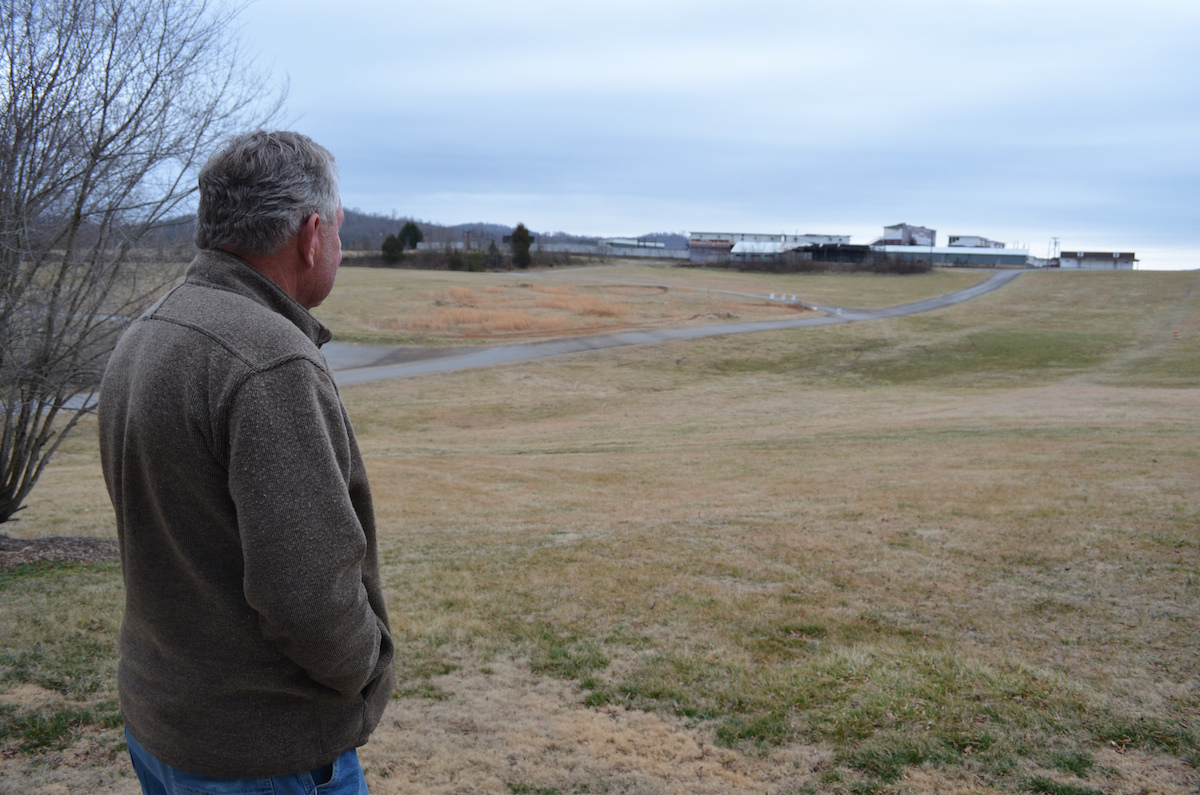
Dean Combs had 200 gallons of corn liquor seized by Alcohol Law Enforcement agents. Then they blew up his still. People a dozen miles away felt the boom.
Ask around about Dean Combs in Wilkes County, in northwest North Carolina, and you get a variation on the same story: Nice guy, good driver, made liquor, got busted. Larry Bentley works the bar at the B&D Quick Stop No. 3, a decades-old, cinder-block former gas station that slings Budweiser and features Jimmy Spencer’s old wrecked No. 23 stock car out front where the pumps used to be. Dean comes in here, he says. Yup, Dean got busted. Jim Priester says Dean stops by his store on Main Street in North Wilkesboro to buy clothes. Jim’s brother-in-law Dale was an ATF agent. His first moonshine bust in Wilkes County was Dean Combs. “He fought him,” Jim says.
On a Sunday, Dean Combs opens the door at an unassuming brick house that sits across a field from the speedway, bologna sandwich in hand. He’s just back from a hunting trip in Georgia. Killed 23 quail, he says. He, his wife and his grandson sit in their living room, watching football as he talks. Only a few racing trophies sit out, a small sampling of the dozens he has in storage. A colored-pencil sketch of Dean from 1981 — beige cowboy hat, blue eyes and cropped mustache, good lookin’ — hangs on the wall.
“That was just a deal that I was, uh,” he says, sighing, searching for an explanation for the moonshine bust. He has a hard time finding one at first. “I don’t know,” he repeats a couple times. Combs, now 63 and graying, speaks with a hoarse, Country and -Western twang. Yeah, they blew one up, he says. But I still have the other one.
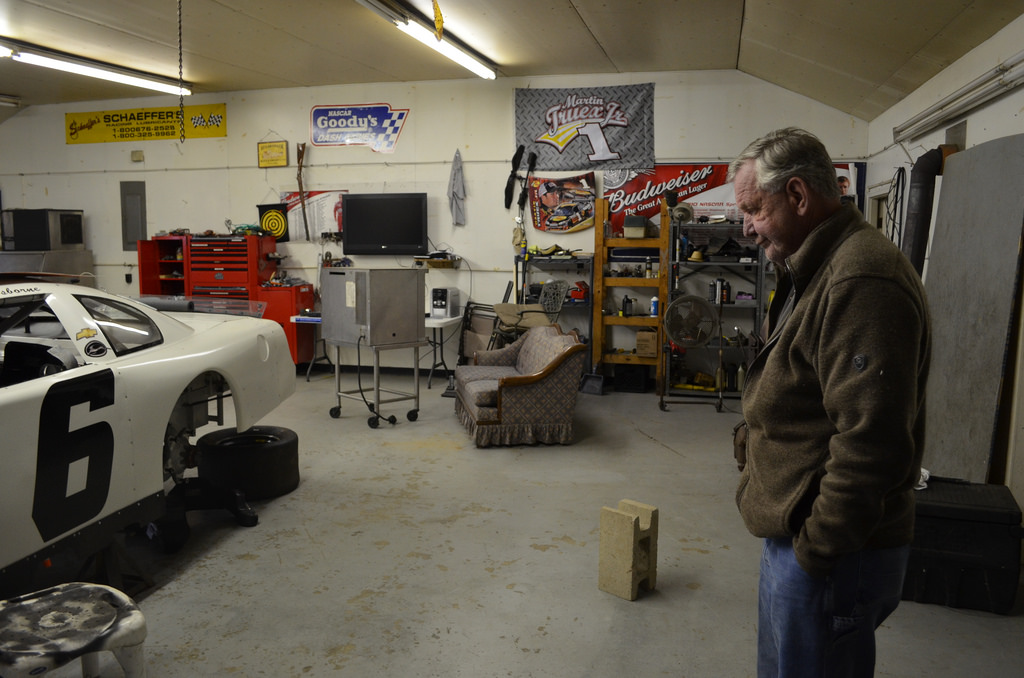
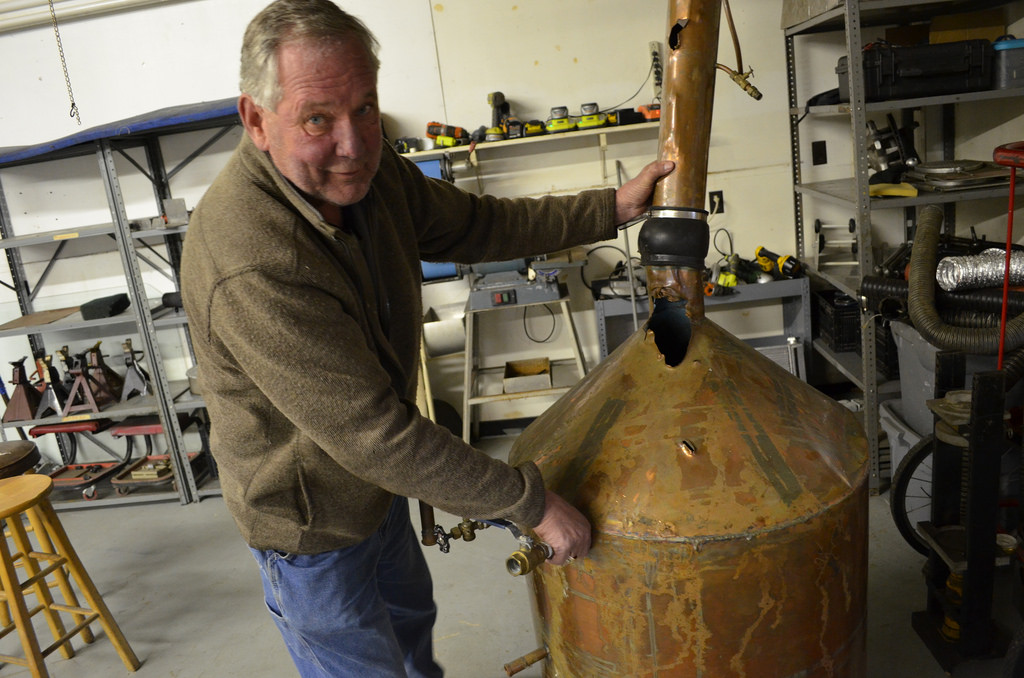
Dean grabs the copper still by the neck. There’s a hole blown in the side. The metal clangs loudly off the concrete floor. It’s as tall as he is. The other one was three times this size. “This thing here actually ran automatic,” Dean says. “I could go out here and mow grass for six hours and come back and have 10–12 gallons of liquor.”
He made good sippin’ brandy, he says, at least 20 proof stronger than what you can buy down at the ABC store. He remembers a younger guy coming to his house around Christmas time one year. He took a big swig of Dean’s brandy.
“Boy, you gone,” Dean told him.
“What do you mean, I’m gone?”
“You gone.”
Not long afterward, the guy fell off Dean’s back porch and landed on his head.
He told a lot of people about his brandy. Probably why he got caught. “Everybody knew it,” he laughs. “I was proud of what I was doing.”
Before Dean Combs got busted in March 2009, the law hadn’t found a moonshine still in Wilkes County in a year and a half. There were a lot of reasons. Tips on stills were vague and rare. People who make liquor never generally talked much about it. Still don’t, unless they know you. ALE agents had mostly moved on from moonshine to busting underage kids buying beer at convenience stores. A liquor stakeout? No time. The Wilkes County ALE and ATF offices closed. The agents moved down to Hickory, and had 12 other counties to cover. Of course, not as many people make liquor anymore. It doesn’t pay like it used to.
Dean says he always wanted to make liquor. His mom’s side of the family was all moonshiners. His daddy, Jack Combs, made liquor and got busted in the 1940s for conspiracy. So Dean read books on moonshine. He looked up recipes.
And he’d built race cars. How hard could building a still be? He wanted to go legit … eventually. “It was something I wanted to do, to live that era, I guess,” he says. “The moonshine era’s gone. It’s over with.”
Moonshine wasn’t born here, but it thrived in the rolling green hills of Wilkes County like nowhere else. Prohibition drove up the price. Then came The Great Depression and farming couldn’t pay the bills. Liquor could. And in the mountains, there were plenty of places to hide. In 1950, a journalist named Vance Packard came to town, looked around and called Wilkes County “the Moonshine Capital of America,” and the reputation has never quite gone away.
On the drive up from Charlotte, NASCAR’s home base, the landscape gets lumpier when you hit the Wilkes County line. There’s a winery. And double-wides. There are longleaf pines and fields planted with corn and soybeans. An AM station plays bluegrass. On the FM dial, there’s rock.
Behind the counter of a family restaurant next to the Yadkin River in Wilkesboro, two waitresses do their best to describe what things are like in Wilkes County now.
“It’s boring,” says a waitress named Ashlyn.
The other waitress, Nerys Cothren, chimes in. “If I were Ashlyn’s age (17), I would run as fast as I could as soon as I got out of high school. For my age (37), this is the best place to live,” she says. “Take this place. You can come in here and eat all you want to off this buffet for $7.99. You go to Charlotte, you’re going to pay $12.99. You won’t find that kind of cooking down there anyways.”
Then she starts talking about growing marijuana. People in her family did it. “I mean, that’s the only way you can make money around here,” she says.
It wasn’t always like this. Decades ago, Wilkes County was a place where hard work, a fast car and the ability to stay one step ahead of the law did more than just make you gobs of money, it could make you a legend. The liquor gave birth to fast cars to haul it. The cars gave birth to a speedway to prove it. The speedway gave birth to NASCAR to legitimize it. And all of it, the liquor, cars, speedway and NASCAR, created Junior Johnson, a legend, The Last American Hero, a man whose exploits spawned a generation of racers, stories and country songs. It was an era that created the pillars of modern southern mythology: Fast cars! Racin’! Moonshine!
Dean Combs saw it end. First, moonshine left. Then NASCAR took off. Now even Junior Johnson is gone.
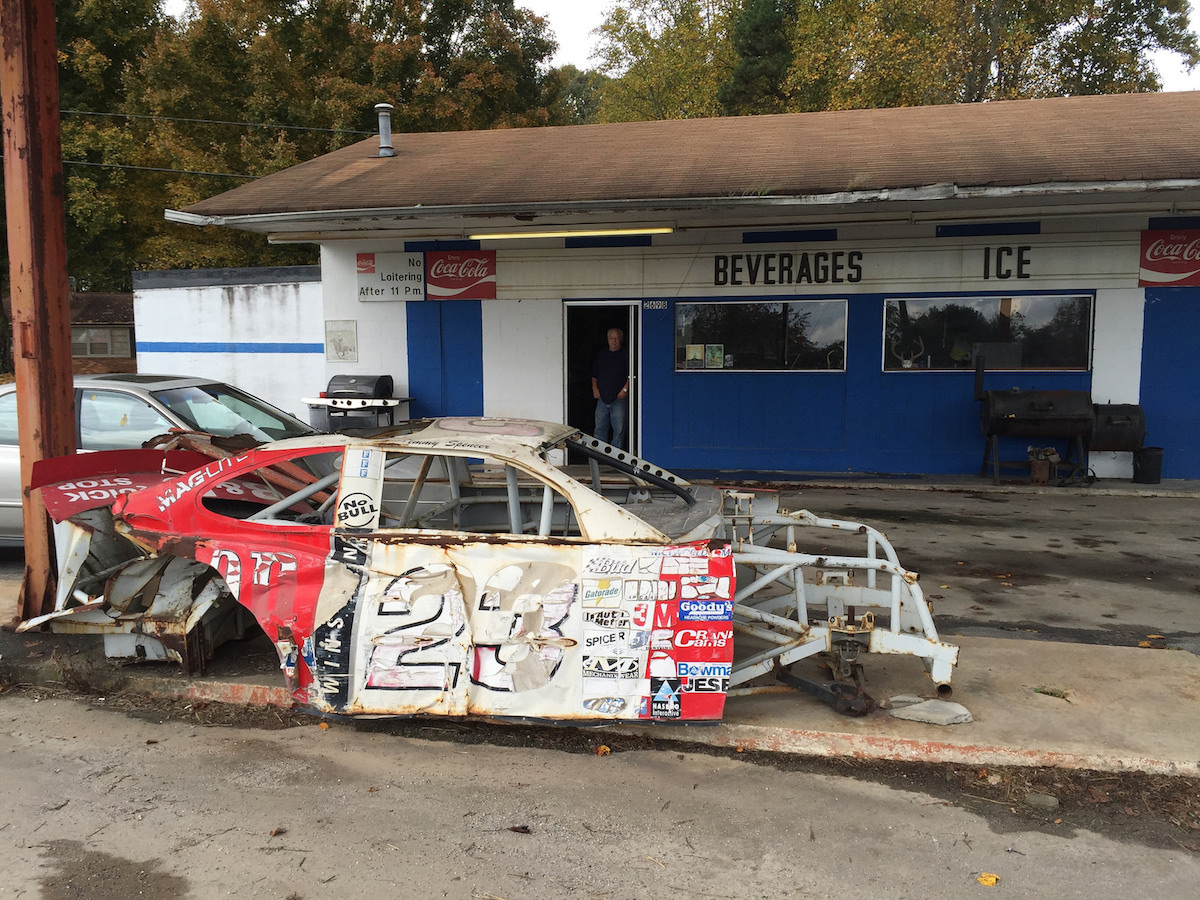
North Wilkesboro helped birth the sport, but there hasn't been a NASCAR race there since 1996.
There’s something that could be done there. Hang out in Wilkes County long enough, and you’ll hear someone say it. The track was never demolished like so many others; it’s clearly visible to anyone driving down the four-lane Highway 421 on their way from Winston-Salem to Boone, or Charlotte to Bristol.
As you drive by, the backside of the grandstands in turns one and two emerges from the trees. A Winston Cup billboard, peeling, untouched for years, still looks out over the freeway. It’s not tucked away, or hidden in some out-of-the-way place. It’s right off the main road, standing tall, a constant reminder of what was, and what no longer is.
There hasn’t been a NASCAR race at North Wilkesboro since 1996. Since then, NASCAR has continued to grow, opening superspeedways in places like Illinois, Texas and California. But North Wilkesboro stayed silent. In 18 years, only a handful of races of any kind have been held there. Down the road in places like Hickory, Gastonia, Winston-Salem and Elkin, short-track racing, the kind that bore NASCAR, goes on. Sure, it’s a tough-gettin’-tougher racket, but it still goes on. And yet at North Wilkesboro, the short track where NASCAR was arguably born, next to nothing’s been going on for almost two decades. What happened to it? To all of it? To racing, liquor and Junior Johnson?
Dean Combs knows. A few others do too.
Part II.ENOCH
“If you think about it — all that dust flying up there, people eating hot dogs — everybody got a little piece of that guy.”
Enoch was a gentle 6’4, 230-pound mountain man who built a dirt ⅝-mile dirt-track oval three miles outside of North Wilkesboro in 1946 because his brother Gwyn drove a fast car. He and a few friends went down to South Carolina to watch a race before that and were impressed by the crowds. Back in Wilkes County, the bootleggers were always talking about who was faster, but had no place to prove it. At a track, you could. So Enoch and a few others scraped up enough to find out. Then Enoch ran out of money before the grading work was finished. That left the front stretch a downhill, and the backstretch an uphill.

Top: Sara Christian (No. 71) and Curtis Turner (No. 41) race during the 1949 Wilkes 200. Bottom: The field prepares for the start of the 1950 Wilkes 200.
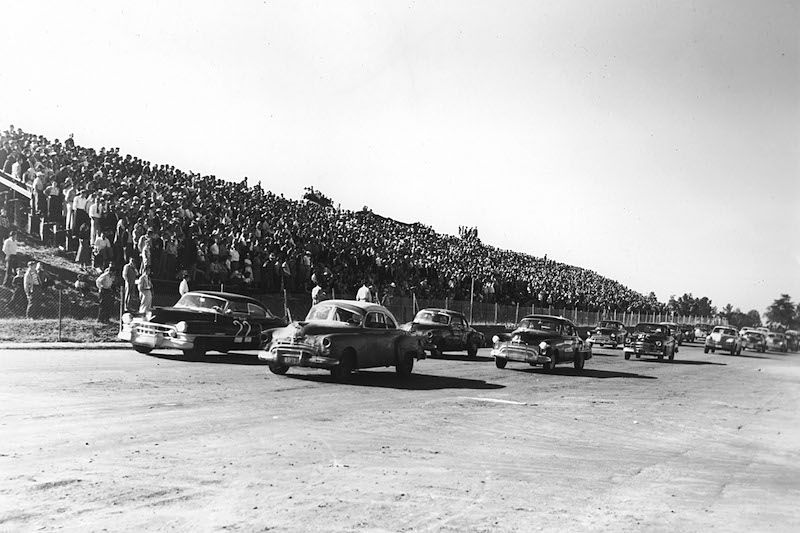
Photos: ISC Images & Archives/Getty Images
At the meeting, the promoters all agreed to meet again later in the year at a hotel in Daytona Beach. There, they agreed to create the National Association for Stock Car Auto Racing, NASCAR, an organization that would come up with rules and crown a national champion each year. France became president. And in return for Staley’s support, France agreed to give North Wilkesboro at least one race a year.
Enoch’s track got the last race of the very first NASCAR season in 1949. Fifty-seven miles per hour won the pole. Bob Flock, a former moonshine runner in an Oldsmobile, won it.
At first, Enoch had seen the track as a side business, but in 1951, he started running two NASCAR races a season. He brought on Dean’s dad, Jack Combs, as co-owner in 1952. He financed his stake with moonshine money.
Every year, they came, more and faster: The Hudsons, Plymouths, Fords, Chryslers, and Studebakers. And big names. In 1954, Dick Rathmann blew a tire with three laps to go and still won. Fireball Roberts won there. So did Buck Baker. In 1957, Enoch paved the track, and it got faster. Eighty-one mph won the pole. Then 82. 86. 93! In 1958, Junior Johnson won the first of four races there, fresh off a stint in federal prison.
Richard Petty won 15 times at North Wilkesboro, but it was 1970 before anyone saw him do it on live TV. By the time ABC’s “Wide World of Sports” joined the Gwyn Staley 400 in-progress, Petty had already taken the lead on lap 52 and was at least a lap ahead of the rest of the field. He didn’t give it up. “All the young girls love Richard,” broadcaster Jim McKay said of Petty. “He’s got those long sideburns now to make him look like a Confederate war hero.” McKay treated the race less like a competition and more like a county fair. The track is so short! People wreck! This place is in the middle of nowhere! Yet look at the crowd! So rowdy! They sure do love racin’ up here!
Maybe it already seemed like an oddity because NASCAR had already started its push toward bigger, faster and longer. In the 1960s, superspeedways broke ground in Atlanta, Pocono and Talladega. By 1975, the Daytona 500 was offering a purse of more than a quarter-million dollars. North Wilkesboro (and other short tracks like Bristol, Richmond and Nashville) couldn’t even put up $50,000. Flush with cash from ticket sales, bigger tracks could offer more and build more. A sellout a Daytona meant 110,000 fans then. North Wilkesboro? Fifteen thousand.
Staley and Combs tried to keep up. Over time, they added seats and grandstands, at one point hitting a capacity of 60,000. But instead of building luxury boxes for rich people, they kept ticket prices affordable. They sold beer cheap. On Speedway property, the parking and camping were free. Jack Combs built a house near the track, and that’s where the Pettys kept their cars before the races. The furniture in the drivers’ lounges was atrociously out of date. “Back then it was just a racetrack with grandstands and that was it,” says Rusty Wallace, the NASCAR Hall of Fame driver who won three times at North Wilkesboro. “Some of the directions [to get there] were to drive down 421 and turn right at Junior Johnson’s old car he had on the corner.”
“Wasn’t no money ever made there much,” says Dean Combs, “until the last years, maybe.”
The purses were small, but the racing was close, crowded and unique. The downhill and uphill stretches meant a driver had to change his style back and forth, lap after lap. Going too fast downhill would put you in the wall in turn one. But on the backstretch, you could mash the gas and sweetly tap the brakes to scoot through turns three and four.
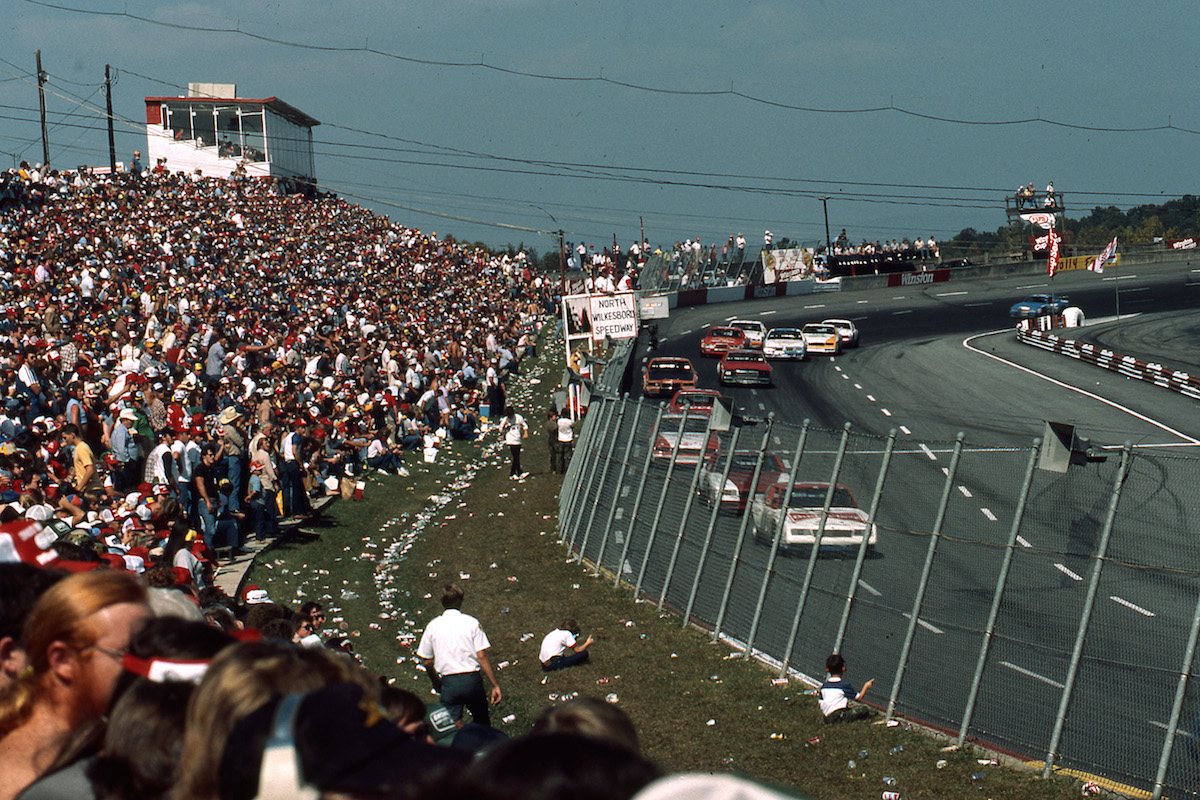
As
more money flowed into the sport, North Wilkesboro, with the lowest
crowd capacity in all of Winston Cup and its unique driving conditions,
became a high-risk, low-reward race.
Photo: ISC Images & Archives/Getty Images
Earnhardt won five times at North Wilkesboro, and when he didn’t, man did he get pissed. In 1989 at the Holly Farms 400, Earnhardt tried to cut back inside Ricky Rudd on the last lap and all it took was a tap for both of them to spin out and lose to Geoff Bodine. Their pit crews confronted each other. “I gave him the whole bottom lane, he knocked the shit out of me,” Earnhardt told ESPN. “They oughta fine that sumbitch and make him sit out the rest of the year.”
By the 1990s, though, North Wilkesboro was starting to feel like a relic, a part of the past NASCAR’s new fans didn’t much value. One sports writer complained that of the four phones in the press box, three were still rotary. Parking was a pain in the ass. Traffic always backed up on the last few miles of two-lane road to the track. Hotel and motel rooms were hard to find for people who didn’t show up in RVs. Some car owners didn’t want to risk their million-dollar investments on a track almost guaranteed to ding them up.
More money started flowing into the sport. ESPN started televising races in the early-1980s, and as cable television began to grow, so did the number of channels showing NASCAR. ESPN2 launched in 1993, and “RPM2Night,” a nightly show dedicated to racing, went on the air on Labor Day 1995. “It was in your face,” says Andrew Maness, an economist who runs racingnomics.com. “It introduced auto racing to people who had no opinion on it.” People had more money to spend. Sponsorships flowed in. And yet, for a while, the races went on at North Wilkesboro, which had the lowest crowd capacity in all of Winston Cup. The winner, with one exception, still got less than $100,000. The risk was high. The reward was low.
“As long as my dad ran the Speedway and my family was involved, they would have been there,” says Mike Staley, who says that his father was, at one point, on NASCAR’s payroll, with offices at Daytona and Talladega. When Bill France, Sr. was trying to teach his son about the business so he could take it over someday, he sent him to learn from Enoch Staley. “Bill [France], Jr. asked my dad one time if he could get by on one race a year,” says Mike Staley. Enoch said he didn’t think he could. France didn’t ask again.
And then, in May 1995, everything changed. “When my dad died,” says Mike, “all the buzzards came in.”

Part III.JUNIOR
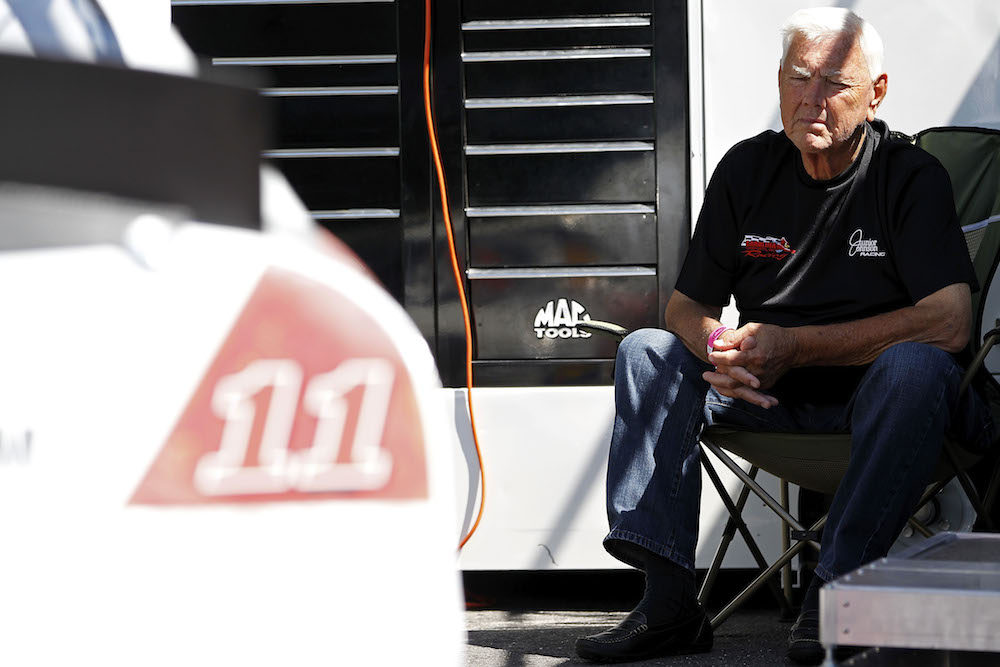
Geoff Burke/Getty Images
Nothing happens at first. He continues to tell a story. Then Junior notices and gently pushes on the gas.
Junior pulls into the Park Place Restaurant in Pineville, a family-owned breakfast joint. He doesn’t come here often. Only two or three times a week, he says. They serve country-sized meals. Before he orders, two waitresses in purple polo shirts walk up, grinning.
“I was wondering if you’d do me a favor?” one asks.
“Yes ma’am,” he says.
“Will you sign my bottle?”
“Ha!”
“I have one at home too,” the other waitress says. “Next time I’m gonna bring mine.”
“I have like 50 of them at home,” says the first waitress. “We go every day after work and drink some moonshine.”
He signs the bottle, an empty jar of the legal liquor that bears his name: Junior Johnson’s Midnight Moon Apple Pie.
“We’re in the presence of a celebrity,” says a bearded guy at the next table.
Junior laughs. “No,” he says, “you’re in the presence of somebody who doesn’t know what he wants to do.”
For most of his life, Junior Johnson always knew what he wanted to do: drive fast, make liquor, race cars. Long after he’d retired from driving a race car he still had a farm in Yadkin County, N.C., only a few miles from where he grew up. He’d get up at 4 and start working, and wrap up around 7 at night, the hours a by-product of his got-something-to-hide personality. During his racing days, he’d hire people to do grunt work on his cars during normal hours. But before they got there and after they left, he’d do the stuff that gave him an edge. Those guys couldn’t know too much, lest other race teams hire them away to spill his secrets. Junior put electric jackscrews in his cars, controlled by a button only he knew about, to make the car tighter or looser whenever he felt like it. He’d fill roll bars with BBs to get the car to the right pre-race weight, then hit a button to let them out while he was running laps to make his car lighter and faster. Junior was the original NASCAR hacker.
Eventually, he’d get caught. Junior says the NASCAR rulebook as we know it is a result of Bill France, Sr. finding out what he was doing and then banning it. Years later, he said France told him that if he weren’t so hard on him, NASCAR wouldn’t have made it. Only Junior would’ve won.
Junior moved down to Charlotte in 2012 after he came down with a staph infection that nearly killed him. He got better, but couldn’t physically keep the farm going, so he sold it. “I miss the farm, but you move on when you need to,” he says. “If you forget the bad stuff that happened to you, you’re better off to forget it.”
Now, Junior Johnson lives in Quail Hollow, near some of the most powerful people in Charlotte. His lot is smaller. His house is bigger. There’s no room for a race shop anymore. He doesn’t wear his overalls as much. His neighbors are all rich. Rick Hendrick has a house there. So do John Fox and Ron Rivera, the former and current head coaches of the Carolina Panthers. Junior’s house sits near the Quail Hollow Club, which will host the PGA Championship in 2017. Most of his neighbors are members. “I don’t much care for golf,” Junior says. “Never really had the time.”
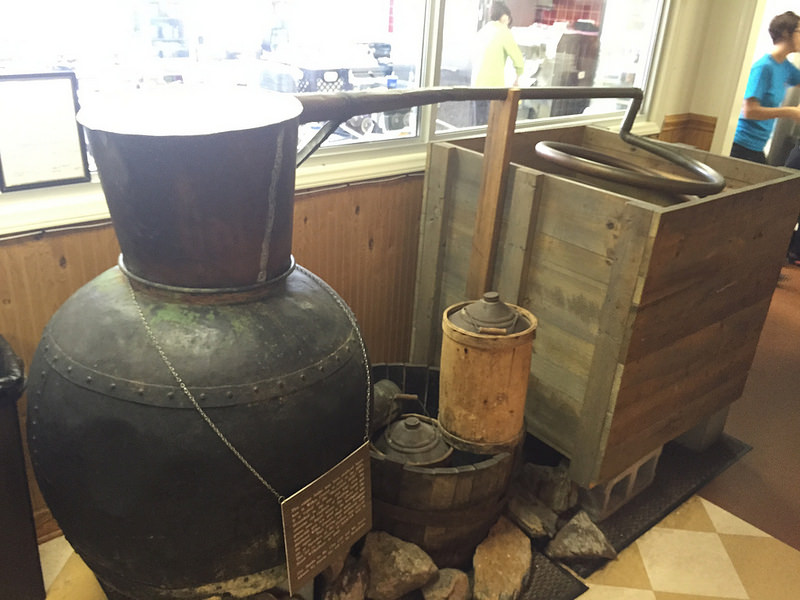
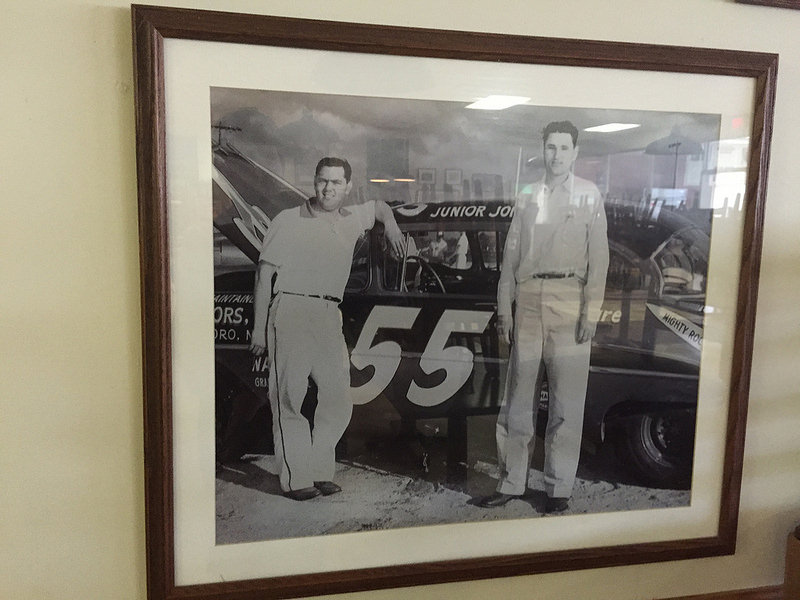
Over at Jim Priester’s clothing store on Main Street, they’re still talking about him.
“Junior’s in high cotton down there,” says Jim.
“He’s completely out of his element,” says Andy Soots, a councilman over in Wilkesboro. “I’ll tell you that.”
There’s a lot of talk about Junior that way. Yeah, he got famous, but there were other guys up here who hauled a lot more moonshine. Other guys were better drivers. Other guys made better liquor. He should get back up here more. All of Wilkes County seems to look at Junior Johnson as their little brother: He’s done well, but you guys don’t know him like we know him.
Jim remembers a guy named Clarence Benton. “Little bitty guy,” he says. Clarence was a bootlegger. Jim says he had a saying: “I’d have been famous too, just like Junior Johnson … if I’d have gotten caught.”
Junior Johnson stories float around racing and the mountains like the morning fog. Here’s one: A long time ago he holed up in a barn down in Kannapolis at 2 a.m., hiding from revenuers who had set up a roadblock. The farmer hears something, comes out and recognizes the guy — Hey, you’re Junior Johnson. Junior gave him 10 bottles of liquor and the farmer told him he could hide there any time he wanted.
Want to know how Junior became a guy with his name on moonshine and a highway sign? It was, of all things, a New York magazine and a young writer named Tom Wolfe. His Esquire story, “The Last American Hero is Junior Johnson. Yes!” hit newsstands in 1965:
The legend of Junior Johnson! In this legend, here is a country boy, Junior Johnson, one of the biggest copper still operators of all times … It was Junior Johnson specifically, however, who was famous for the “bootleg turn” or “about-face,” in which, if the Alcohol Tax agents had a roadblock up for you or were too close behind, you threw the car into second gear, cocked the wheel, stepped on the accelerator and made the car’s rear end skid around in a complete 180-degree arc, a complete about-face, and tore on back up the road exactly the way you came from. God! The alcohol tax agents used to burn over Junior Johnson.
Since then, Junior Johnson has been trying to live up to that legend. His mug shot, from his arrest in 1955 for firing up his daddy’s still, is prominently featured on the website of the company that makes the moonshine that bears his name. Most stuff up in Wilkes was made with sugar, but he uses corn, which lasts longer. It’s his daddy’s recipe. His daddy made good liquor, he says.
Junior makes appearances for the NASCAR Hall of Fame. He built the moonshine still that’s displayed there. He constantly travels to tracks, signing autographs here and driving pace cars there. He’s not a private person, but he’s found life beyond Ingle Hollow and the Brushy Mountains. It’s hard living near the people you grew up with. They expect a lot out of you. He had some business deals go bad up there. Sometimes, he says, “It’s better off if you go off and find a quiet place.”
Back on the road after breakfast, Junior sees some flashing blue lights up ahead. Charlotte-Mecklenburg Police have some people pulled over and they’re blocking the right lane, which he’s in. The traffic picks up, and nobody will let Junior Johnson over. Finally, Johnson veers his Mercedes swiftly into as much of the left lane as he can get, finding a narrow gap in between the police cruiser and the car in front and the one in back to get around. He does not use a turn signal. A half-mile up the road, he needs to turn left, and a car is running alongside him at the same speed, two-wide on Park Road. He puts the pedal down and the Mercedes purrs and roars past the poor guy, the latest in a long line of people to get passed by Junior Johnson. The guy honks as the Mercedes pulls in front of him.
Junior, who became suddenly quiet as he weaved in and out of traffic, finally speaks. “Lucky I didn’t wreck you, buddy,” he says, laughing quietly.
Part IV.RAY
“It was still warm,” Jim says. “I’ll tell you what I did with that quart of white liquor. I took it to a club in Winston-Salem and passed it around, and we had the whole place drunk.”
“Off that one quart?” says Andy Soots, the councilman in Wilkesboro.
“Off that one quart. That stuff would crank a vehicle.”
“Yeah, you need to keep a jug in the back of your car just in case you run out of fuel.”
“If you buy today, you have to know somebody,” says Andy. What if you don’t? “Somebody might tell you they’ll bring you some, but they wouldn’t show up.” A few weeks ago, a guy, 80 years old, came through town from California, driving a ’57 Chevy. He was looking for peach brandy. He talked to a fella. They made a deal. They were supposed to meet up. And right on cue, that fella left and never came back.
Go talk to Ray, Andy says. A while later, Ray Wilborn shows up in front of a still that sits under an aluminum shelter in Wilkesboro, next to a radiator shop that burned down a few months before. The guy who owned this place did more work on stills than he did radiators, Ray says. He’s looking intently at his setup, loudly critiquing it. He says back in the day, if he was running this still, he’d do it the right way. Ray could probably bring in $3,000 a week. In 1960 dollars. He quickly does the math. Six cases of liquor would take three 100-pound bags of sugar. You could get 12 cases a day from this. At around $40 a case, you could make $500 a day.
That’s a lot of work. “I’ll tell you, there’s nothing as hard — damn sawmillin’ is easier than making liquor,” he says. “That’s the hardest job you’ll ever do.”

To Ray, Junior Johnson is just another guy he saw hanging around town when he was growing up. But unlike Junior, Ray never got caught.
Another one: Ever heard of Roy Matheson? No? Roy used to haul liquor for Yadkin Fred. Faster than everyone. “He had a damn ’39 Ford, it’d run 160 mph,” he says. “The motor cost $10,000 out of Reading, Pennsylvania.” Sometimes his buddies would get caught and their cars would get seized by the local sheriff. When they got out of jail, they’d just go to the auction and buy them right back with cash. To Ray, Junior Johnson is just another guy he saw hanging around town when he was growing up. But unlike Junior, Ray never got caught.
Ray starts listing all the cars he had by age 17: a ’50 Oldsmobile Coupe with a supercharger. A pickup truck. A new Pontiac. His principal asked him how it was that a student had nicer cars than the teachers. “What’s wrong with that?” he said.
Ray would get calls. One guy in Tennessee would call and say something like, I need 25 pigs, and Ray would hop in a car or truck and head out just across the state line to a golf course, where the buyer had two guys ready to unload 25 cases of liquor inside a barn. Another regular customer had him show up at a preacher’s house in Bluefield, Va., Ray would pull the truck up, the tires sitting on marks, and a guy pushed a button and the whole truck disappeared into a basement.
He tried to go legit once. For his daddy, Big Ed. “I went to Lowe’s Hardware in 1961 when they caught my daddy the last time,” he says. Ray was sitting on $52,000. First he went out and bought a new car and a new house. And then went to work and looked at his first new paycheck. “You know what I was getting a week? Fifty-four damn dollars a week,” he says. “I draw two checks, and I told the bossman ’count me off.’” By 1970, Ray had made enough money from moonshine liquor to retire. At age 30.
What’s Ray been doing since? “Nothin’,” he says. He laughs. But he says it again.
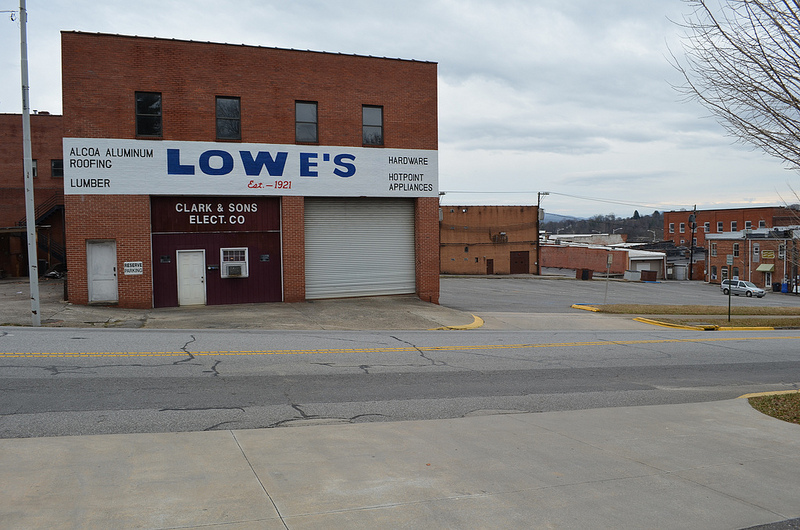
Sitting on $52,000, Ray went ‘legit’ and got a job at Lowe’s Hardware. His first check was for $54. He lasted two weeks.
You might trip over an old still up in the woods, but there’s no way you’ll find one running out there anymore. Too many hunters. A sheriff’s deputy might see it from a chopper while looking for marijuana. Anything that’s made is made indoors now, says Ray. He knows of two brothers who have been running the same still for six years. That’s rare. Extremely rare. Two years ago, Ray helped some other guys build a still. Their setup was terrible. Ray jumped in, pointing and hollering about how it was all wrong and that, if they left it the way it was, the damn thing would explode.
“They run that thing all winter. I told them I wanted some brandy. That’s all I charged them,” says Ray. “Them cocksuckers never gave me a damn bit.”
Of course, Ray won’t name names, or say where they’re doing it. Don’t bother asking to go see it. The honor code — don’t shoot, don’t talk, just drive — is still strong with him. If he was still making liquor, “you couldn’t even get to talk to me,” he says.
If you get caught now, he says, it’s your own damn fault. You talked. You weren’t paying attention. Your still blew up. There just aren’t enough agents snooping around like there were in Ray’s day. Shon Tally says he nabbed a NASCAR guy once. A hauler driver for Ginn Racing. Caught him at the Wilco truck stop down in Troutman. Said he was taking moonshine around to NASCAR races to give to friends. After he got Dean Combs, Tally says his last liquor bust before leaving ALE happened because a guy was loading up an old Ryder truck with sugar from a Sam’s Club over in Winston-Salem.
Old box trucks always make him suspicious. So Tally and his partner followed him all the way back to his chicken house, and found the still’s discharge pipe running into a creek. The owner appeared and, knowing he was caught, just gave up and showed them around. That’s the thing about moonshiners, Tally says. They’ll put up a fight if they can get away. But if they’re caught, they’re caught.
They found the guy’s Rolodex. It had been thumbed-through and opened to one particular name and phone number: Junior Johnson.
Part V.BRUTON
“Yeah, he’s an asshole,” one elected official says. He’s far from the only one who’s said it, but he starts backpedaling, thinking twice about whether he wants to be on the record calling Bruton Smith an asshole. Like a lot of people, he still wants to talk with Bruton.
Nobody wants to piss him off. Some government folks tried to hold up a dragway he was building a few years ago. You do that, Bruton said, and I’ll move my speedway out of Charlotte. The whole damn thing. So those same folks named a road after him. They flew a banner over the track. “We (heart) you Bruton,” it read. Bruton commands enough wary respect around racetracks and racing that nobody really has to say his last name.
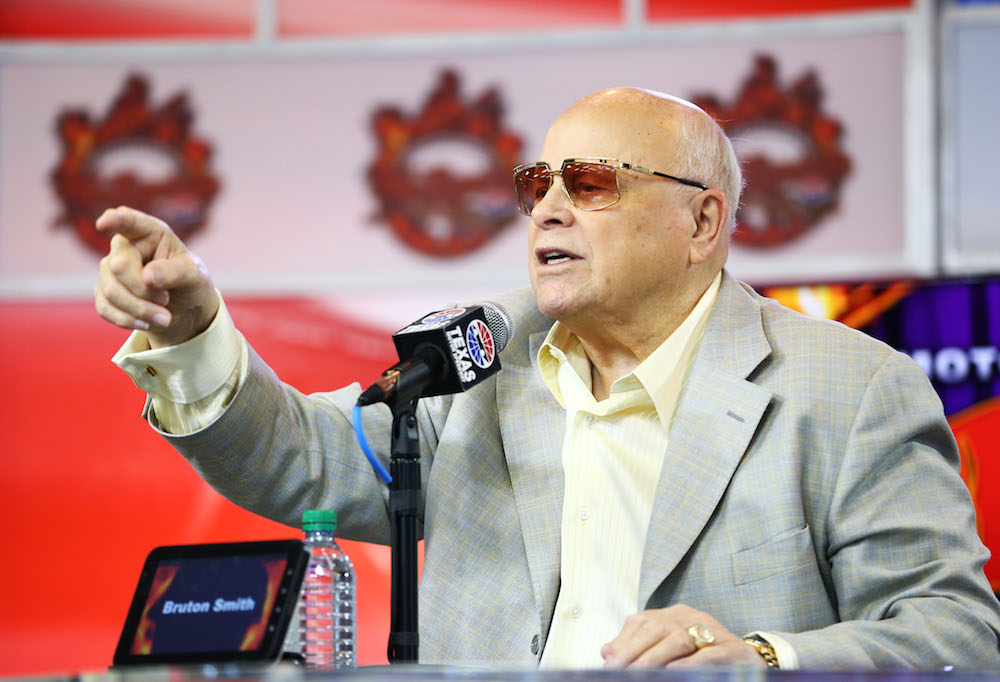
Ronald Martinez/Getty Images
When Enoch Staley died in 1995, Bruton Smith saw his opportunity to get the NASCAR race he wanted.
When Enoch Staley died that May, Bruton saw his opportunity. He went to the Combs family, and asked if they’d sell their half of the Speedway. He said he’d take one date and move it to Texas in 1997. But Dean Combs said Bruton told the family he had plans to keep the place open. “Bruton showed a picture of the racetrack, and it looked like Bristol [does today]. What he said he wanted to do was run a Wednesday night primetime race.” By the next month, Jack Combs and his family sold his share for $6 million. Both men celebrated with a bottle of moonshine.
Bruton immediately got into his black Cadillac, drove over to Mike Staley’s office, and announced that he was his new partner. The Staleys were shocked. They hadn’t planned on selling the track to anybody. But then reality set in. “I couldn’t be partners with Bruton,” Mike says. He worried that he’d be outgunned by a co-owner who was a multi-millionaire.
And then, another multi-millionaire showed up in Staley’s office. Bob Bahre had built up the mile-long New Hampshire International Speedway in 1990, and was trying to get a second Winston Cup race there. He told Staley about his plan. I’ll buy the track. I’ll take the Winston Cup date. And I’ll give the track back to you. Maybe you can keep running Busch (now Xfinity) Series and truck races there. I don’t want it. “It was an old track, and it wasn’t up to snuff,” says Bahre, now 88. “It wouldn’t be anywhere near what we could make up in Loudon with one race. I don’t think anyone who would have bought it would have kept the dates there.”
Enoch’s widow Mary was adamant. She would not sell to Bruton Smith. So in January 1996, the Staleys sold to Bahre for $8 million. “[Bruton] got his cheaper than I did, though,” says Bahre. “He got in there first.”
After that, each man went to Bill France, Jr., who finally agreed to move both race dates for the 1997 season. The spring and fall races at North Wilkesboro in 1996 would be the last.
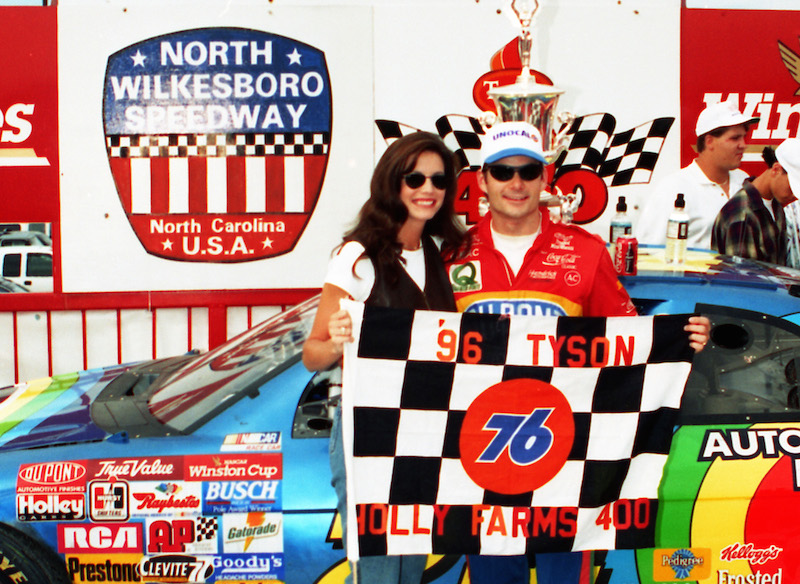
Photo: ISC Images & Archives/Getty Images
Top: Jeff Gordon celebrates his 1996 Holly Farms 400 win, the last NASCAR race to be held at the North Wilkesboro Speedway. Bottom: The Speedway, almost 20 years later.
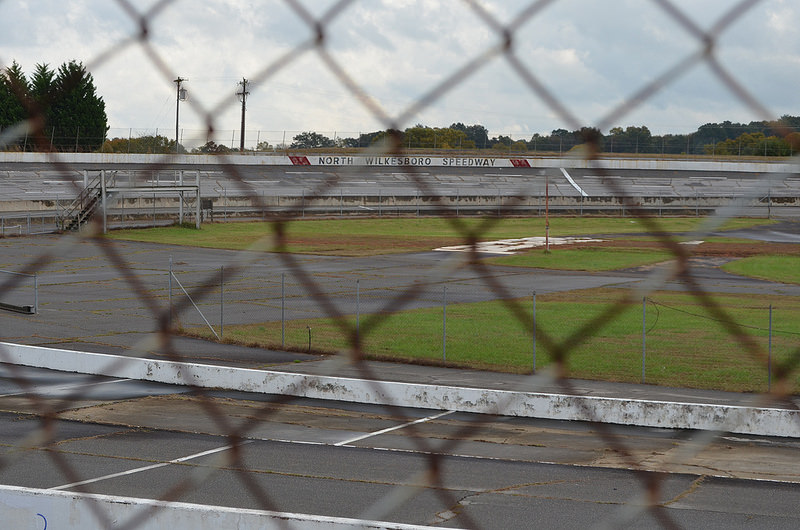
“We don’t want to leave our roots behind. We don’t want to forsake the people who helped us get where we are. But time marches on. I think we call it progress.”
Sheriff’s deputies told Bruton to stay away from the last race, the Holly Farms 400, that September. They couldn’t guarantee his safety. The race was a sellout. The new face of NASCAR, Jeff Gordon, started in the front row, going back and forth with Dale Earnhardt before taking the lead back for good with 79 laps to go. For the last time, a Winston Cup car was hoisted to victory lane on the checkered-painted rooftop of the media center in the infield. Ninety-three Cup races. Forty-seven years. All at an end. “This is North Wilkesboro,” Gordon told ESPN. “I’m not supposed to win at North Wilkesboro or Martinsville. I don’t know what’s going on.”
Everyone assumed the place would still stay open in some capacity. But Bruton and Bahre, as 50-50 owners, couldn’t agree on anything. They’d bought the racing dates, more than the track, and neither really ever wanted to run a race there.
And so the track stayed closed.
In 2007, Bob Bahre and his son Gary decided they’d had enough of the speedway business, and Bruton made them an offer to buy their track in Loudon. When Bahre said yes, Bruton Smith, reluctantly, became the full owner of North Wilkesboro. “He didn’t want to take that part,” Bahre says. “But I wouldn’t take it. What the hell good was it?”
“The last time I saw it,” Bruton told a reporter in 2009, “It was just slowly returning to the earth.” Rusting away like an old still left out in the woods.
Part VI.PAUL
Paul barely speaks. Everybody says he’s quiet. He’s a little suspicious. Other folks will talk about Paul more than he will. Just ask him how long he’s been working here.
“That’s my business,” Paul says, politely but firmly.
Have time to chat?
“I don’t chat.”
Paul stands in front of his home a few yards from the ticket office, wearing an old, oversized white polo shirt, a beat-up cap and sunglasses with yellow lenses. He was expecting a visitor. Most people don’t give him warning. Sometimes they knock on his door. Sometimes they’ll catch him out on the mower. Most are just passing through, see the track from 421, and decide to stop in. A lot of gawkers come during the week before races in Charlotte, Bristol and Martinsville, which are all within a two-hour drive. They all ask the same question: Can you let me in?
Like he usually does, Paul hobbles over to the gate, pulls out some keys, and sticks one into a padlock.
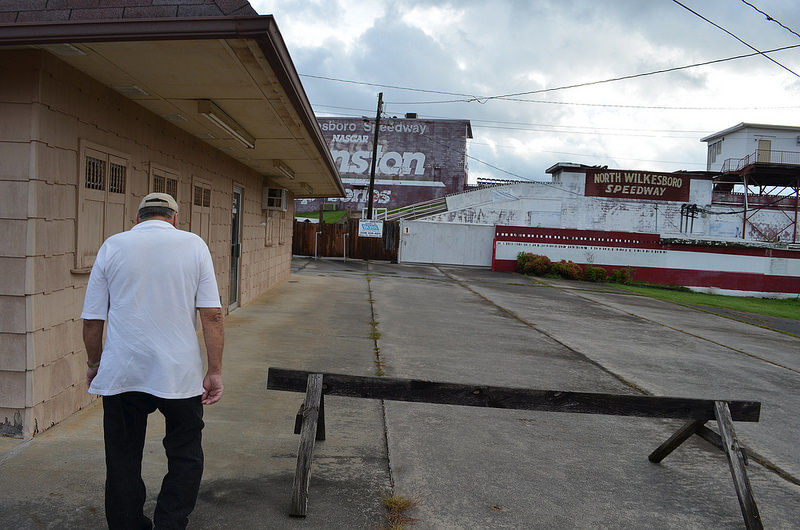
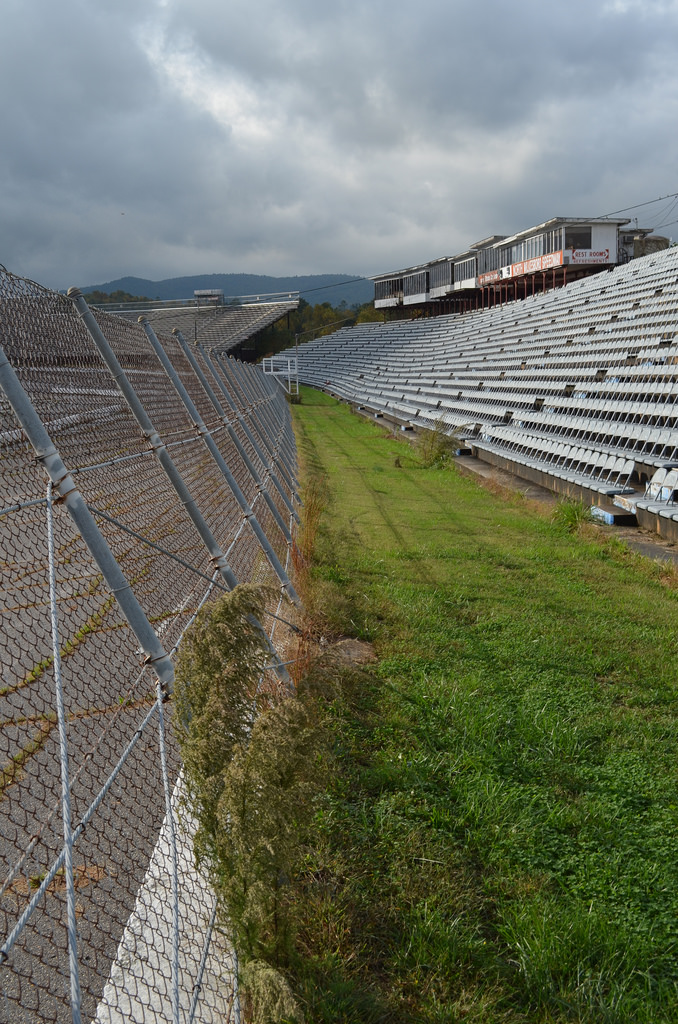
The driving school never started up. Cameras never came. Turned out Collins had arrest warrants from Florida and Georgia. Cops said he never paid his vendors, never followed through on promises to renovate the track, and a woman who signed up for his school claimed never got a refund. Collins spent eight months in prison.
Another guy gave it a try. Alton McBride Jr. was his name. He pulled it off for a little while. McBride ran several late-model races there in 2010-11. Chase Elliott, all of 14 years old and now the heir apparent to Jeff Gordon’s No. 24 Chevrolet, won the first race at North Wilkesboro in 14 years. McBride and his guys put some paint on the walls, sealed cracks in the track, and held a few more races and concerts and tractor pulls before giving up. McBride blames a lack of support from the local government. But he knows that short-track racing has never been a tougher business than it is now. “It’s not like anyone gave us money and got gone,” McBride says. “The money was never there from day one.”
The consensus among people in Wilkes County who want racing back is that it would take support from the rarest of species: a millionaire who loves racing and doesn’t mind losing money. “You have to have people that have deep pockets and don’t care a lot if they take a little bit of loss on it, for the love of the sport,” says North Wilkesboro Mayor Robert Johnson, who did electrical work on the track when it reopened in 2010. He says county leaders are willing to run water and sewer lines to the track. For the right buyer.
The right buyer just hasn’t come, says Speedway Motorsports, which declined to make Bruton Smith available for an interview. “At present Speedway Motorsports has no plan for development or renovation at North Wilkesboro,” said company spokesman Scott Cooper. “It’s a historical piece of NASCAR property, and if the right opportunity presented itself, we would entertain offers to sell it.”
“He doesn’t need to sell it,” says Humpy Wheeler, the former president of Speedway Motorsports. Every year, Speedway Motorsports writes a check for $39,119.95 to cover the property taxes. That’s the sum of what the speedway now generates for the local economy. The track isn’t even listed among Speedway Motorsports’ eight venues. “It’s in the Sargasso Sea with no wind,” Wheeler says.
It’s too small, says Jim Priester, still talking with Andy at the store. “You’d have to have seating into High Point to make it feasible.”
“You would,” says Andy.
It may be too late anyway. “People in the community’s gotten used to not hearing those racecars run,” says Andy. Beside, racing costs too much. “It’s gettin’ took away from the common person.”
There’s a strong case to be made that NASCAR is moving further away from the fans that originally made it successful. But even as speedways like Atlanta and Charlotte tear out tens of thousands of consistently empty seats, and ratings decline, the sport just signed a 10-year, $8.2 billion TV deal with Fox and NBC.
Still, it’s hard to look at the track and not see racing. Darlington, which lost its beloved Labor Day race to California in 2003, will get the Southern 500 back on that day this year. If that gets your imagination going, you might see a faint sliver of hope for North Wilkesboro to return, for NASCAR to nod symbolically to its southern roots, its history, maybe turn North Wilkesboro into what Fenway Park is to baseball. It feels good to think that. How awesome would that be?
Video courtesy SkySprinter.com
People keep mentioning Junior Johnson’s name when they bring up the track. I heard maybe he’ll buy it. I heard he’s been talking with Bruton. But Junior’s not interested. Bruton’s a good guy, he says. Good businessman. He doesn’t know why he’d sell the track. “I don’t think he can sell it,” he says, laughing. “Nobody would buy it.”
Junior always wanted to run well at North Wilkesboro. He started racing there. “I didn’t live but ten miles from it and I didn’t want people to come up there to beat me,” he says. Back when his son Robert wanted to learn to race, he’d go up there and run a brush hog over the asphalt to cut down the weeds growing up through the cracks. There’s a lot you can learn by driving there, he says.
But Junior doesn’t want to get involved. He’s done being The Last American Hero. “I don’t have nothing for Wilkes County,” he says. “and it don’t have nothing for me.”
There’s not much time to look around or take pictures. Paul looks like he has things to do. He’s not in the mood to talk much.
You have to walk up a slight hill to get to the front stretch grandstands, where it’s easier to look around. The buildings and boxes are painted in a fading red, with white Winston Cup lettering and logos draped across cinder block walls, billboards and concrete barriers. The seating along the front stretch consists of aluminum chairs bolted into cement. All that separates the stands from the track is a strip of short grass and a tall chain link fence that angles out over the pavement. It still looks like the pictures from the good old days, just … older.
The place has an eerie emptiness. The gray clouds blow in over the Brushy Mountains. It’s quiet. Ghostly.
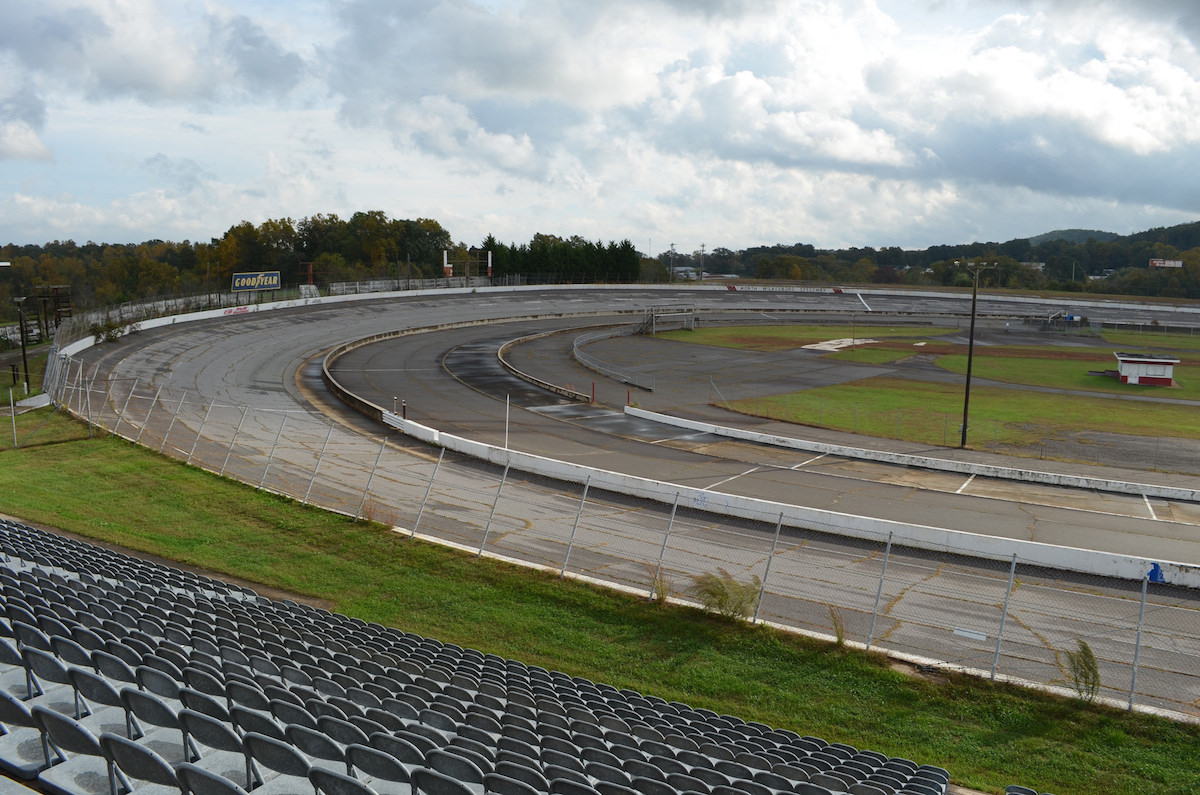
But if you come in with hope, and you squint a little, you see things differently. The track pavement is worn down but maybe you could save it with some crack sealing. The weeds have grown up tall in hard-to-mow places, but in most other spots Paul has kept the grass short and neat. Some of the VIP boxes look OK. Maybe that’s a testament to the way Paul has kept this place up over the years: A fix here, some mowing there. Places abandoned last year look worse than a place NASCAR left behind almost 19 years ago.
And that’s the deception here. The past looks so close, so physically present. You can reach out and touch an aluminum chair. You can see the scoring tower still standing. There’s the garages where haulers lined up for decades. The paint on the red-and-white barriers is peeling but still visible. The asphalt looks old, but drivable. It is all still there, aching to be used again. You want to jump in a car, holler and floor it.
It is not possible to walk around the place, even for a few minutes, without thinking about what was, and wish racing could somehow be this close, this quaint, this intimate again. The bad times are gone, and the mind fills in the gaps with hope. What if, you think. What if …
There is so much to see. To explore. To look at more closely. But today, it’s not going to happen, because Paul seems to be getting impatient. After about 10 minutes, he walks back down the hill, past the big fading NASCAR logo on the cinder block wall and out the front entrance, the only noise the gate rolling closed and the padlock clicking shut. http://www.sbnation.com/longform/2015/3/4/8126311/north-wilkesboro-speedway-after-nascar



No comments:
Post a Comment